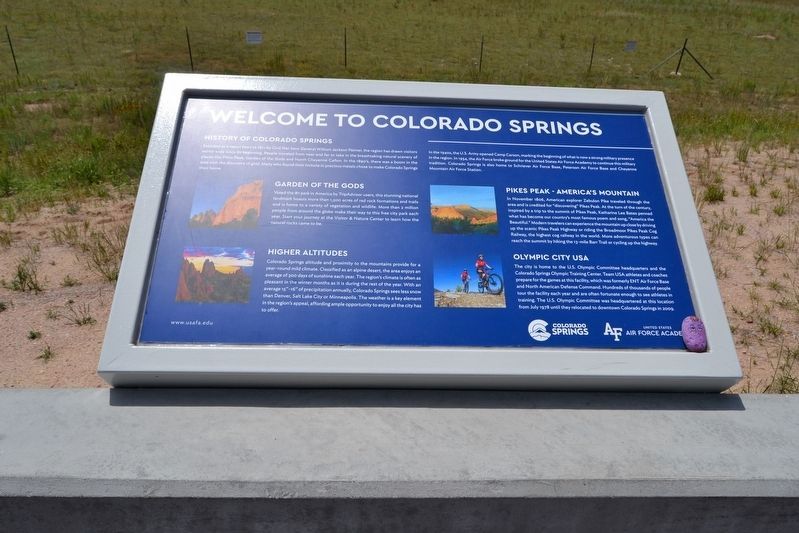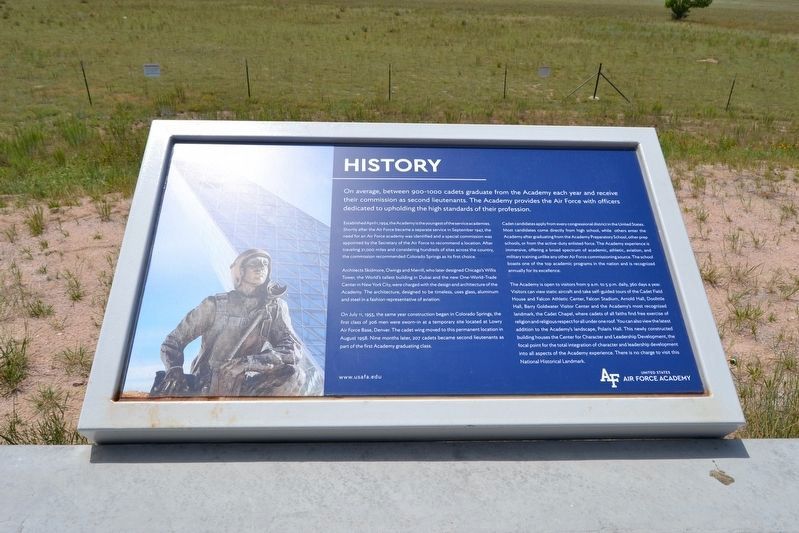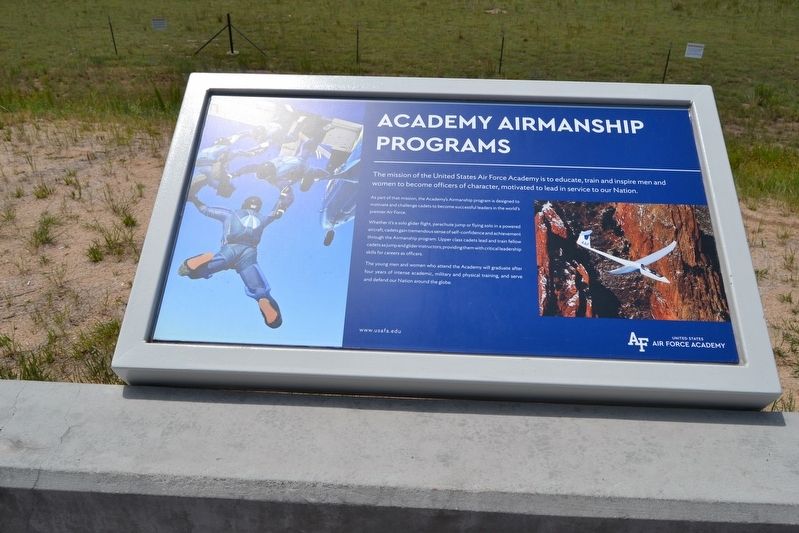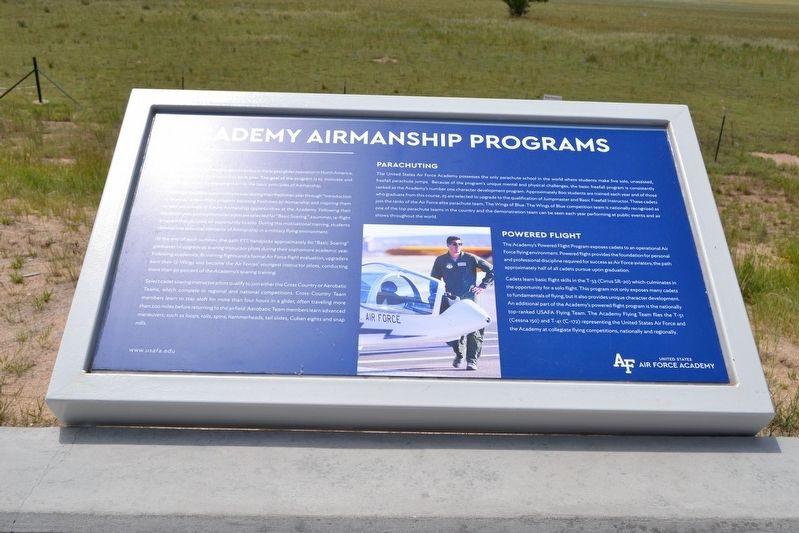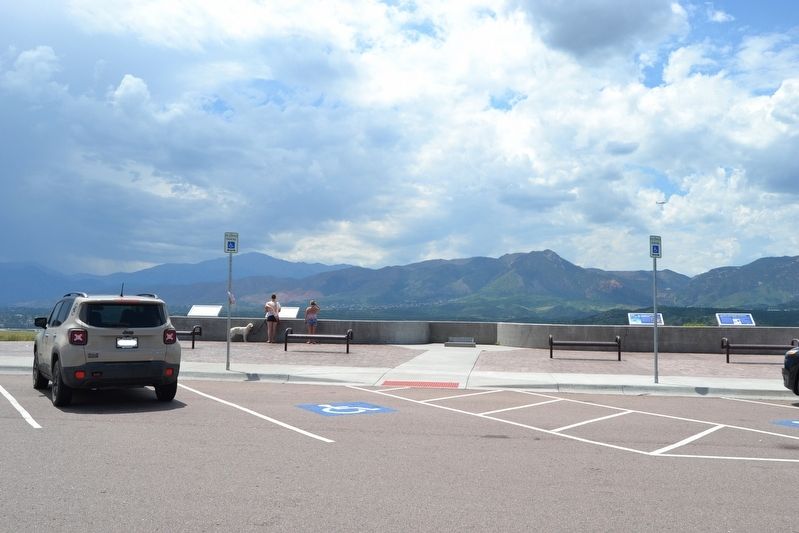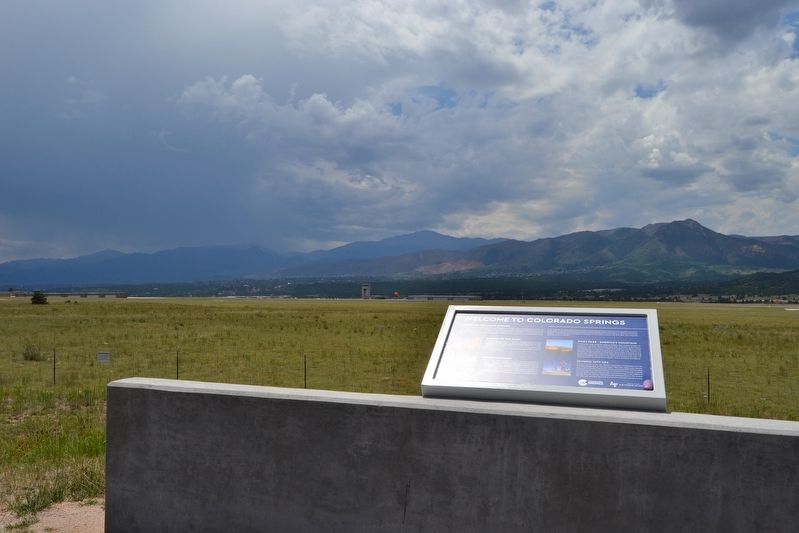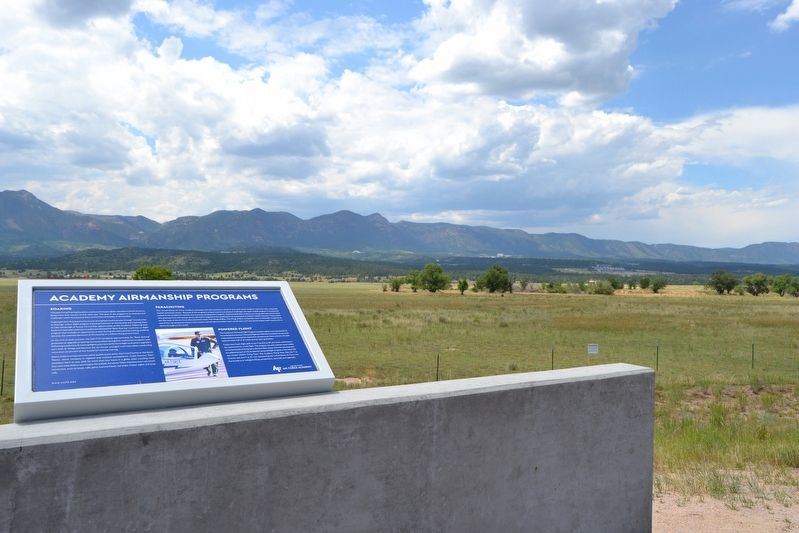Colorado Springs in El Paso County, Colorado — The American Mountains (Southwest)
United States Air Force Academy
Inscription.
Welcome to Colorado Springs
History of Colorado Springs
Founded as a resort town in 1871 by Civil War hero General William Jackson Palmer, the region has drawn visitors world-wide since its beginning. People traveled near and far to take in the breathtaking natural scenery of places like Pikes Peak, Garden of the Gods and North Cheyenne Cañon. In the 1890’s, there was a boom in the area with the discovery of gold. Many who found their fortune in precious metals chose to make Colorado Springs their home.
In the 1940s, the U.S. Army opened Camp Carson, making the beginning of what is now a strong military presence in the region. In 1954, the Air Force broke ground for the United States Air Force Academy to continue this military tradition. Colorado Springs is also home to Schriever Air Force Base, Peterson Air Force Base and Cheyenne Mountain Air Force Station.
Garden of the Gods
Voted the #1 park in America by TripAdvisor users, this stunning national landmark boasts more than 1,300 acres of red rock formations and trails and is home to a variety of vegetation and wildlife. More than 2 million people from around the globe make their way to this free city city park each year. Start your journey at the Visitor & Nature Center to learn how the natural rocks came to be.
Higher Altitudes
Colorado Springs altitude and proximity to the mountains provide for a year-round mild climate. Classified as an alpine desert, the area enjoys an average of 300 days of sunshine each year. The region’s climate is often as pleasant in the winter months as it is during the rest of the year. With an average 15"-16" of precipitation annually, Colorado Springs sees less snow than Denver, Salt Lake City or Minneapolis. The weather is a key element in the region’s appeal, affording ample opportunity to enjoy all the city has to offer.
Pikes Peak - America’s Mountain
In November 1806, American explorer Zebulon Pike traveled through the area and is credited for “discovering” Pikes Peak. At the turn of the century, inspired by a trip to the summit of Pikes Peak, Katharine Lee Bates penned what has become our country’s most famous poem and song, “America the Beautiful.” Modern travelers can experience the mountain up close by driving up the scenic Pikes Peak Highway or riding the Broadmoor Pikes Peak Cog Railway, the highest cog railway in the world. More adventurous types can reach the summit by hiking the 13-mile Barr Trail or cycling up the highway.
Olympic City USA
The city is home to the U.S. Olympic Committee headquarters and the Colorado Springs Olympic Training Center. Team USA athletes and coaches prepare for the games at this facility, which was formerly ENT Air Force Base and North American Defense Command. Hundreds of thousands of people tour the facility each year and are often fortunate enough to see athletes in training. The U.S. Olympic Committee was headquartered at this location from July 1978 until they relocated to downtown Colorado Springs in 2009.
History
On average, between 900-1000 cadets graduate from the Academy each year and receive their commission as second lieutenants. The Academy provides the Air Force with officers dedicated to upholding the high standards of their profession.
Established April 1, 1954, the Academy is the youngest of the service academies. Shortly after the Air Force became a separate service in September 1947, the need for an Air Force academy was identified and a special commission was appointed by the Secretary of the Air Force to recommend a location. After traveling 21,000 miles and considering hundreds of sites across the country, the commission recommended Colorado Springs as its first choice.
Architects Skidmore, Owings and Merrill, who later designed Chicago’s Willis Tower, the World’s tallest building in Dubai and the new One-World-Trade Center in New York City, were charged with the design and architecture of the Academy. The architecture, designed to be timeless, uses glass, aluminum
and steel in a fashion representative of aviation.
On July 11, 1955, the same year construction began in Colorado Springs, the first class of 306 men were sworn-in at a temporary site located at Lowry Air Force Base, Denver. The cadet wing moved to this permanent location in August 1958, Nine months later, 207 cadets became second lieutenants as part of the first Academy graduating class.
Cadet candidates apply from every congressional district in the United States. Most candidates come directly from high school, while others enter the Academy after graduating from the Academy Preparatory School, other prep schools, or from the active-duty enlisted force. The Academy experience is immersive, offering a broad spectrum of academic, athletic, aviation, and military training unlike any other Air Force commissioning source. The school boasts one of the top academic programs in the nation and is recognized annually for its excellence.
The Academy is open to visitors from 9 a.m. to 5 p.m. daily, 360 days a year. Visitors can view static aircraft and take self-guided tours of the Cadet Field House and Falcon Athletic Center, Falcon Stadium, Arnold Hall, Doolittle Hall, Barry Goldwater Visitor Center and the Academy’s most recognized landmark, the Cadet Chapel, where cadets of all faiths find free exercise of religion and religious respect for all under
one roof. You can also view the latest addition to the Academy’s landscape, Polaris Hall. This newly constructed building houses the Center for Character and Leadership Development, the focal point for the total integration of character and leadership development into all aspects of the Academy experience. There is no charge to visit this National Historical Landmark.
Academy Airmanship Programs
The mission of the United States Air Force Academy is to educate, train and inspire men and women to become officers of character, motivated to lead in service to our Nation.
As part of that mission, the Academy’s Airmanship program is designed to motivate and challenge cadets to become successful leaders in the world’s premier Air Force.
Whether it’s a solo glider flight, parachute jump or flying solo in a powered aircraft, cadets gain tremendous sense of self-confidence and achievement through the Airmanship program. Upper class cadets lead and train fellow cadets as jump and glider instructors; providing them with critical leadership skills for careers as officers.
The young men and women who attend the Academy will graduate after four years of intense academic, military and physical training, and serve and defend our Nation around the globe.
Academy Airmanship Programs
Soaring
The 94th
Flying Training Squadron conducts the largest glider operation in North America, flying more than 20,000 sorties each year. The goal of the program is to motivate and challenge cadets by exposing them to the basic principles of Airmanship.
Cadets get their first opportunity to soar during their freshman year through “Introduction to Soaring,” a four-flight program exposing freshman to Airmanship and inspiring them to take advantage of future Airmanship opportunities at the Academy. Following their freshmen year, 300 sophomore cadets are selected for “Basic Soaring,” a summer, 14-flight program that includes an opportunity to solo. During this motivational training, students develop the essential elements of Airmanship in a military flying environment.
At the end of each summer, the 94th FTS handpicks approximately 80 “Basic Soaring” graduates to upgrade as soaring instructor pilots during their sophomore academic year. Following academics, 81 training flights and a formal Air Force flight evaluation, upgraders earn their G-Wings and become the Air Forces’ youngest instructor pilots, conducting more than 90 percent of the Academy’s soaring training.
Select cadet soaring instructor pilots qualify to join either the Cross Country or Aerobatic Teams, which compete in regional and national competitions. Cross-Country
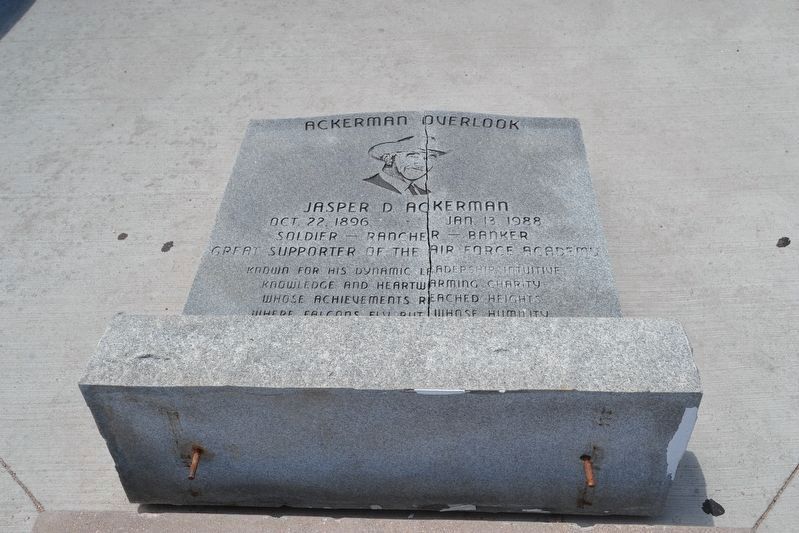
Photographed By Duane Hall, July 18, 2017
6. The Damaged "Ackerman Overlook" Marker
October 22, 1896 to Jan. 13, 1988
Soldier - Rancher - Banker
Great Supporter of the Air Force Academy
Known for his dynamic leadership, intuitive knowledge and heartwarming charity whose achievements reached heights where falcons fly, but whose humility remained firmly on the ground.
Colorado Springs Executives Association
Dedicated Oct. 22, 1988
Parachuting
The United States Air Force Academy possesses the only parachute school in the world where students make five solo, unassisted, freefall parachute jumps. Because of the program’s unique mental and physical challenges, the basic freefall program is consistently ranked as the Academy’s number one character development program. Approximately 800 students are trained each year and of those who graduate from this course, 25 are selected to upgrade to the qualification of Jumpmaster and Basic Freefall Instructor. These cadets join the ranks of the Air Force elite parachute team, The Wings of Blue. The Wings of Blue competition team is nationally recognized as one of the top parachute teams in the country and the demonstration team can be seen each year performing at public events and air shows throughout the world.
Powered Flight
The Academy’s Powered Flight Program exposes cadets to an operational Air Force flying environment. Powered flight provides the foundation for personal and professional discipline required for success as Air Force aviators; the path approximately
half of all cadets pursue upon graduation.
Cadets learn basic flight skills in the T-53 (Cirrus SR-20) which culminates in the opportunity for a solo flight. This program not only exposes many cadets to fundamentals of flying, but it also provides unique character development. An additional part of the Academy’s powered flight program is the nationally top-ranked USAFA Flying Team. The Academy Flying Team flies the T-51 (Cessna 150) and T-41 (C-172) representing the United States Air Force and the Academy at collegiate flying competitions, nationally and regionally.
Topics. This historical marker is listed in this topic list: Military.
Location. 38° 58.721′ N, 104° 48.641′ W. Marker is in Colorado Springs, Colorado, in El Paso County. Marker is on Interstate 25 at milepost 152, on the right when traveling south. Marker is located at the Ackerman Overlook between Exit 153 and Exit 151; it is accessible only from the southbound travel lanes of I-25. Touch for map. Marker is in this post office area: Colorado Springs CO 80921, United States of America. Touch for directions.
Other nearby markers. At least 8 other markers are within 4 miles of this marker, measured as the crow flies. Falcon Stadium (approx. 2.1 miles away); The USAFA Falcon (approx. 2.1 miles away); Memorial Pavilion Roll Call Record Locator Room (approx. 3½ miles away); USAF Academy Cemetery Carillon
(approx. 3½ miles away); 20th Air Force (approx. 3½ miles away); 18th Fighter Group • 318th Fighter Group (approx. 3½ miles away); Seventh Fighter Command (approx. 3½ miles away); 499th Bombardment Group (VH) (approx. 3½ miles away).
Credits. This page was last revised on August 20, 2017. It was originally submitted on August 20, 2017, by Duane Hall of Abilene, Texas. This page has been viewed 350 times since then and 19 times this year. Photos: 1, 2, 3, 4, 5, 6, 7, 8. submitted on August 20, 2017, by Duane Hall of Abilene, Texas.
